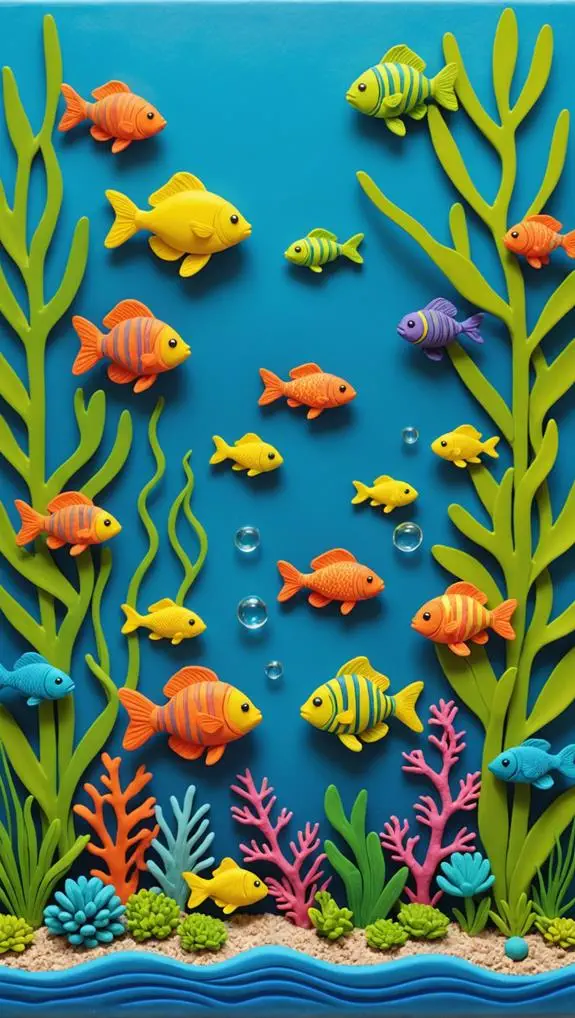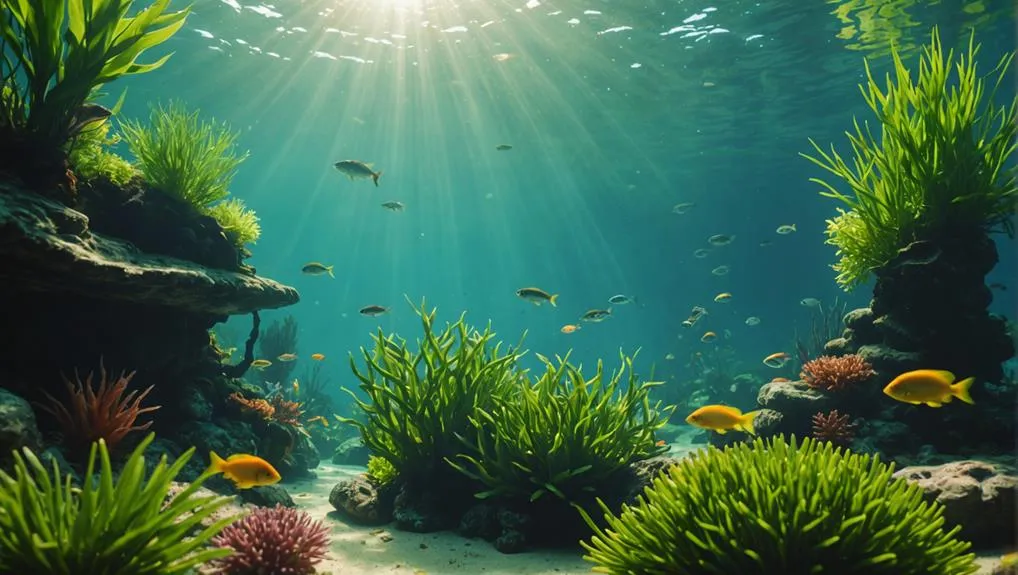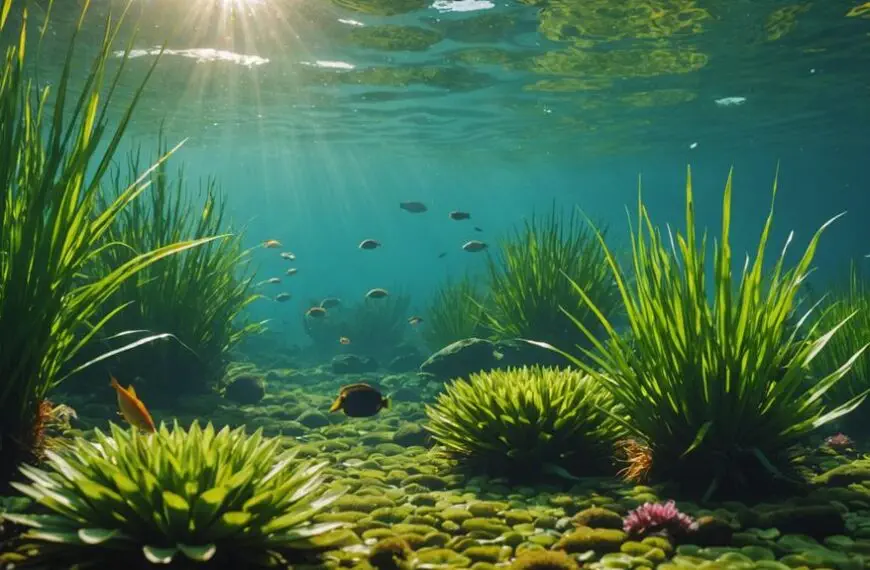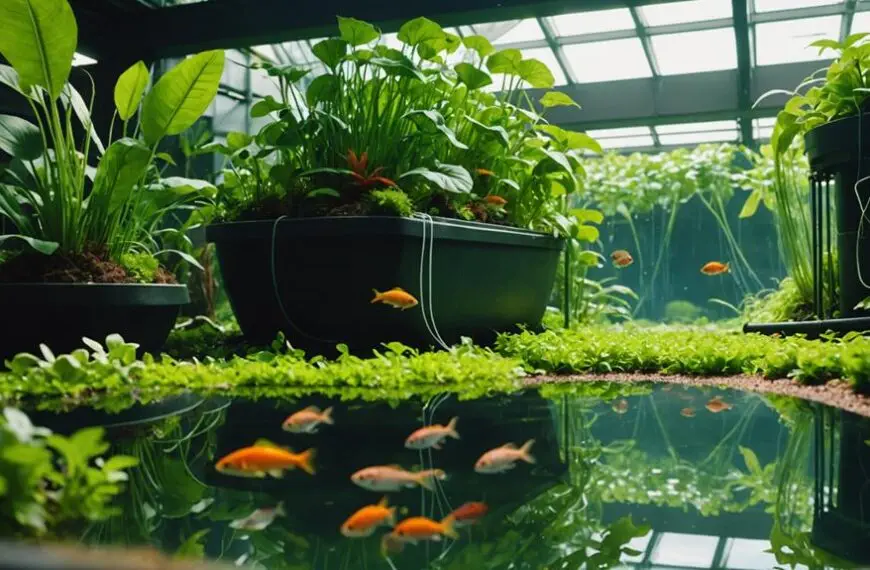Choosing sustainable plants for fish habitats is a no-brainer! They give fish food and shelter, making sure your finned friends are happy. Plus, these plants help clean the water by soaking up pesky nutrients that cause algae blooms. Who wants green soup in their favorite fishing spot? Not you! They also prevent erosion, keeping the shoreline intact and healthy. On top of that, they boost local fish populations and support biodiversity, which is like throwing a party for the ecosystem. And there's more—stick around to discover how these plants can benefit local economies as well!
Contents
Benefits of Sustainable Plants
When you consider the importance of sustainable plants in aquatic environments, their benefits for fish habitats become clear. Native aquatic plants play a vital role in supporting fish life. They provide essential food and shelter, especially for those adorable juvenile fish that need a safe spot to grow.
Plus, these plants work wonders for water quality! By absorbing excess nutrients like phosphorus and nitrogen, they help keep harmful algal blooms at bay, protecting fish populations from nasty surprises. Healthy water quality promotes stable nitrogen cycles, reducing harmful compounds and enhancing the overall health of aquatic ecosystems optimal conditions.
But that's not all! Aquatic vegetation stabilizes sediments and shorelines, making sure the ecosystem stays healthy. This stability supports diverse fish species, ensuring that everyone has a cozy home. Imagine all the different creatures finding shelter among those lush green plants; it's like an underwater neighborhood party!
Sustainable plants also promote biodiversity, which means more fish and fun for everyone involved in fishing activities. They act as natural guardians against invasive species, helping to keep your favorite local fish habitats intact.
Enhancing Fish Habitat
When you think about enhancing fish habitats, native plants play a starring role. They not only provide cozy hiding spots and breeding grounds for fish, but they also help keep the water clean and clear.
Incorporating a variety of sustainable plants promotes long-term solutions for maintaining water quality, as these plants naturally filter and oxygenate the water.
Native Plant Benefits
Native aquatic plants play a crucial role in enhancing fish habitats, providing essential food and shelter that support robust fish populations. When you choose native plants, you're not just beautifying the water; you're creating a thriving community for fish. These plants absorb nutrients, improving water quality and reducing those pesky algae blooms that can harm fish habitats.
Additionally, native plants help stabilize sediments and minimize shoreline erosion, making the environment more resilient for fish breeding and nursery grounds. Think of them as nature's protective blanket!
In places like Texas reservoirs, these plant communities offer critical spawning areas, giving juvenile fish a safe place to grow, which boosts their survival rates.
Research shows that diverse aquatic plants increase habitat complexity, creating refuge from predators and enhancing feeding opportunities. This means happier, healthier fish!
Plus, when you support native plants, you're contributing to increased biodiversity in our ecosystems. So, dive in and embrace native plants—you'll be doing wonders for fish habitats, and maybe even making a few fish friends along the way!
Habitat Diversity Promotion
A diverse array of aquatic plants creates a vibrant ecosystem that significantly enhances fish habitats.
By cultivating various aquatic plant communities, you're not just beautifying the water; you're also providing essential support for fish and wildlife habitat. Here's how:
- Food and Shelter: Different plants offer food and shelter for various fish species, helping them thrive at every life stage.
- Sediment Stabilization: Native plants stabilize sediments, keeping the water clear and reducing turbidity. This is crucial for fish that rely on sight to hunt.
- Oxygen Production: Healthy plant populations boost oxygen levels through photosynthesis, creating a welcoming environment for fish and other aquatic organisms.
These benefits don't just enhance the fish habitat; they also promote a resilient ecosystem that can better withstand changes.
By respecting our Natural Resources and choosing sustainable plants, you're contributing to a healthier environment.
Plus, you might just find yourself enjoying the beauty of these vibrant aquatic communities while knowing you're doing your part for our finned friends.
Water Quality Improvement
Improving water quality is crucial for enhancing fish habitats, and aquatic plants play a vital role in this process. By absorbing excess nutrients like phosphorus and nitrogen, these native plants help keep harmful algal blooms at bay. You won't have to worry about murky water ruining your fishing plans!
With rooted aquatic plants stabilizing sediments, you'll notice better water clarity. This means more sunlight can penetrate, boosting photosynthesis and creating a more productive habitat.
Plus, those vibrant plant communities contribute to higher dissolved oxygen levels, which fish and other aquatic creatures absolutely love.
And let's not forget about sediment control. Aquatic plants help reduce turbidity, ensuring that the water stays clear for your finned friends to thrive.
Healthy plant communities act like nature's buffer, protecting water bodies against temperature and nutrient swings. That makes for a cozy and stable environment for fish species.
Improving Water Quality

Often overlooked, sustainable aquatic plants play a crucial role in enhancing water quality. By choosing these plants for your fish habitats, you're not just creating a pretty picture; you're making a real difference! Here's how sustainable aquatic plants can improve water quality:
- Nutrient Absorption: They absorb excess nutrients like phosphorus and nitrogen, which helps minimize harmful algal blooms and clears up the water. Maintaining optimal pH levels is essential for aquatic life, and these plants contribute to stabilizing those levels.
- Oxygen Production: Through photosynthesis, these plants enhance dissolved oxygen levels, giving fish and other aquatic organisms a healthier environment. High water quality directly supports fish health and well-being, allowing them to thrive.
- Sediment Stabilization: Native plants, like seagrasses, stabilize sediments, reducing turbidity and letting more light in for better plant growth.
When you support healthy native plant communities, you're also promoting natural filtration processes. This not only improves water quality but also strengthens the ecosystem's resilience against environmental changes.
Think of it as creating a cozy, clean home for all the little creatures that call the water their home. So, next time you're thinking about your fish habitat, remember, sustainable aquatic plants are like the unsung heroes of water quality—helping to keep everything fresh and lively!
Supporting Biodiversity
Sustainable aquatic plants are essential for supporting biodiversity in fish habitats. When you choose native plants, you're not just planting; you're creating a thriving community for various fish species.
These plants provide crucial habitats that enhance biodiversity, which is vital for a healthy ecosystem. Imagine about 20 beneficial plant species cultivated for Texas reservoirs, each one bringing its own unique touch to the underwater world!
These plants help stabilize food webs, too. Take seagrasses, for example. They support small fish and invertebrates, which are like the tasty appetizers for larger fish. Without this intricate menu, the whole aquatic community suffers!
Plus, healthy populations of these plants boost ecosystem resilience, allowing biodiversity to bounce back from environmental changes—like a superhero for our lakes!
Studies have shown that more plant diversity, especially native species, means higher productivity. This means your efforts provide more resources for fish and their aquatic neighbors.
Erosion Control and Shoreline Stabilization

When you think about keeping our shorelines safe, native plants really shine.
They don't just look pretty; their roots hold the soil together, reducing erosion and keeping fish habitats intact.
Plus, by using these green heroes, you're helping to protect our precious aquatic ecosystems while enjoying the beauty they bring!
Native Plant Benefits
Establishing native plants along shorelines actively combats erosion and promotes shoreline stabilization. You might wonder why this is important. Well, it's not just about keeping the land intact; it's about creating a safe haven for juvenile fish and maintaining water quality.
Here are three key benefits of using native plants:
- Wave Action Defense: Native plants buffer against strong waves, which helps protect shorelines from erosion. Think of them as nature's bodyguards!
- Root Power: The roots of these plants stabilize sediments, reducing turbidity. This means clearer water, which is essential for aquatic plants to photosynthesize and thrive.
- Ecosystem Resilience: By fostering diverse plant communities, you create a balanced environment. This balance is vital for the health of fish habitats and overall water quality.
When you choose native plants, you're making a choice that benefits not just the shoreline but also the entire ecosystem.
You're helping to ensure that our aquatic friends have a safe and clean home to grow and thrive.
Erosion Reduction Techniques
Effective erosion reduction techniques are essential for maintaining healthy shorelines and fish habitats. You can make a real difference by planting native aquatic plants along coastal waters. These plants have strong root systems that help stabilize sediments, which keeps your shoreline safe from pesky wave action.
Plus, they prevent nutrients from washing away, keeping water clear and inviting for fish.
When you maintain a diverse community of these native plants, you can reduce shoreline erosion by as much as 50%. That's a big win for fisheries management! Not only do these plants improve light conditions for other aquatic plants, but they also create a thriving environment for fish and wildlife.
Imagine the joy of knowing your efforts are enhancing biodiversity!
Establishing native plant buffers isn't just about protection; it's about creating a habitat where fish and wildlife can flourish.
So, the next time you think about your local shoreline, remember that planting native aquatic plants isn't just good for the environment—it's a gift to future generations of creatures that call these waters home.
Let's get planting and watch our ecosystems thrive!
Habitat Protection Strategies
Protecting fish habitats starts with implementing robust habitat protection strategies that focus on erosion control and shoreline stabilization. You can make a real difference by using native aquatic macrophytes, which help curb shoreline erosion and keep our fisheries thriving.
Here are three key strategies to consider:
- Plant native vegetation: These plants are amazing at stabilizing sediments with their roots while reducing wave action. They're like nature's bodyguards for the shoreline!
- Maintain water quality: Healthy plant communities lessen sediment resuspension, leading to clearer waters. Clear water means happier fish and aquatic life. Who doesn't want that?
- Combat habitat loss: By minimizing damage from fluctuating water levels and storm surges, you're helping protect vital breeding grounds for fish and other aquatic organisms.
Economic Value of Aquatic Plants
Aquatic plants play a crucial role in the economic landscape of fisheries. These green superheroes aren't just pretty to look at; they boost local economies significantly. For example, seagrasses can enhance commercial fish harvest by nearly 10 tonnes per hectare each year, which means more fish for you and your fellow anglers.
Healthy plant communities provide essential support to diverse food webs. This is vital for sustaining both recreational and commercial fisheries, which generate billions of dollars annually. When aquatic plants thrive, water quality improves, leading to happier fish and, in turn, bigger catches for everyone involved.
But that's not all! By preserving and restoring these habitats, you're not just helping fish; you're creating jobs in fisheries management, conservation, and eco-tourism. It's a win-win for both nature and the economy!
Regions like Minnesota showcase how effective management of aquatic plants can optimize angler expenditures, resulting in substantial revenue.
Choosing sustainable plants for fish habitats isn't just about nurturing the environment; it's also about supporting livelihoods. So, let's dive into this nourishing world together!
Best Practices for Implementation

When it comes to implementing sustainable practices for fish habitats, utilizing native aquatic plants is key. These plants not only support fish but also help the overall ecosystem thrive.
Here are some best practices to guide you:
- Choose the Right Plant Species: Opt for native aquatic plants that naturally grow in your area. They'll provide food and shelter for fish, improving biodiversity.
- Monitor Water Quality: Keep an eye on water quality before and after planting. This helps you see how sustainable plants boost nutrient levels and oxygen—both vital for happy fish!
- Create a Pond Management Plan: Regularly assess plant coverage to maintain a healthy balance. Aim for 20-50% coverage; too much or too little can upset your aquatic paradise.
Engaging your local community in these efforts can make a big difference. Educating others about the importance of sustainable plants can foster teamwork in maintaining and restoring fish habitats.
After all, when you work together, you not only help the fish but also build a stronger community connection! So roll up your sleeves and dive into this rewarding journey—your fish friends will thank you!
Frequently Asked Questions
Why Are Aquatic Plants Important to the Environment?
Aquatic plants boost water quality, enhance biodiversity, and create essential habitats. By planting them, you're supporting ecosystem health, providing shelter for aquatic life, and ensuring a thriving environment for future generations to enjoy.
Why Are Plants Useful in a Fish Tank?
Plants in your fish tank improve water quality, boost fish health, and enhance oxygen supply. They absorb harmful nutrients while providing habitats and food, creating a thriving environment that benefits both fish and plant life.
Why Are Marine Plants Important to the Ecosystem?
Marine plants boost biodiversity, creating complex habitats for various species. They enhance photosynthesis, improving water quality and supporting life. By nurturing these plants, you help maintain a balanced ecosystem that benefits everyone and everything around you.
What Are the Benefits of Aquatic Plants to a Pond Ecosystem?
Did you know that aquatic plants can produce up to 50% of the oxygen in a pond? They enhance habitats, support nutrient cycling, and boost oxygen production, fostering a thriving ecosystem that benefits both fish and humans.
Final Thoughts
Choosing sustainable plants for fish habitats isn't just a smart move; it's like giving nature a high-five! By enhancing fish homes, improving water quality, and supporting biodiversity, you're making a real difference. Plus, who doesn't love the idea of a clean, thriving ecosystem? Remember, every little choice counts, and your efforts can help keep our waters beautiful and full of life. So, let's dive in and make those sustainable choices together—our fishy friends will thank you!












